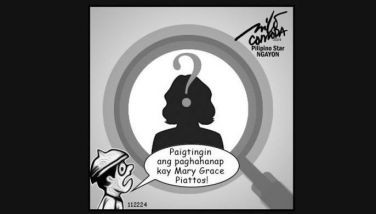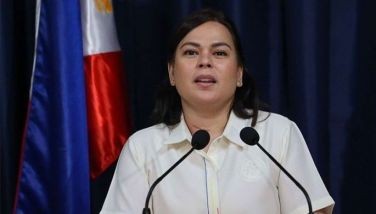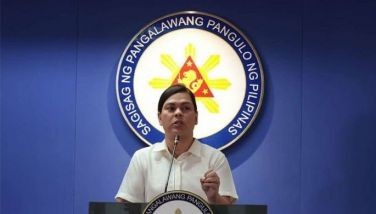Stroke survivors can now overcome muscle tightness
November 16, 2006 | 12:00am
Among the many grave complications of a stroke, one of the most physically incapacitating is uncontrolled muscle tightness, or spasticity.
The pain and limited movements brought about by this condition can make each day a constant struggle for the patient.
Fortunately, a cutting-edge treatment called BoNT-A, also known as Dysport, is now available and is helping more Filipino stroke survivors – and their families – ease their lives.
BoNT-A or Dysport is a form of localized treatment that has been in use for the past 15 to 20 years. It is a local blocking agent, a medication that will deliberately impair transmission between nerve and muscles so that when the brain or the spinal cord sends these abnormal messages of contraction, these messages are no longer transmitted to the muscle, allowing it to loosen up and relax.
According to a recent study of the Stroke Society of the Philippines, a stroke or brain attack (which should be differentiated from a heart attack) occurs in 1.4 out of every 1,000 Filipinos above the age of 20. This condition is therefore not uncommon.
For the fortunate ones who survive the attack, international and local studies show that between 30 to 70 percent will suffer spasticity.
A typical patient who has survived a stroke may in fact be observed with a peculiar posture in which the arm is very tight and often crunched up against the chest, with the fingers sometimes tightly clenched in a fist.
The leg is very stiff, swinging sideways as the patient tries to walk.
They might even be unable to place their foot flat on the floor.
The impact of spasticity is potentially enormous.
If left untreated, it may cause contractions and permanent disfigurement.
The psychological devastation accompanying the condition often causes depression and greatly impacts not only on the patient’s but also on the entire family’s quality of life.
Releasing that over-activity in those muscles would surely produce a welcome sense of satisfaction and elation.
The patient and his or her family may enjoy unexpected, extraordinary benefits just by releasing the excessive tension in muscles.
The most important mainstay in the management of post-stroke spasticity is neurological rehabilitation through a combination of physical and occupational therapy.
Unfortunately, relying solely on a physical approach may provide a slow, painful treatment that may last months, even years, before significant recovery is achieved.
To facilitate movement, doctors may prescribe oral medications designed to loosen the muscles.
A major issue with those treatments, however, is their side effects, most commonly sleepiness, sedation or generalized weakness.
Since oral agents are delivered throughout the entire body, it does not make much sense to give a pill that goes everywhere when spasticity may in fact be only in an arm or a leg.
This is one distinct advantage of BoNT-A treatment. Since it is administered exactly where it is needed, patients and their families need not be afraid of generalized side effects common with oral medications.
When combined with neurological rehabilitation, BoNT-A can provide a quicker and more dramatic improvement in patient movement, posture and gait, aside from relieving the severe pain associated with muscle spasms.
Overall, it may help lift the psychological barrier that may impair a patient’s will to recover – and deliver a better quality of life.
In fact, leading experts in BoNT-A research are now looking into treatment for spasticity, as soon as it appears, the concept being to arrest its onset even before the brain "memorizes" its as a "normal" condition – and makes it more difficult to manage.
Today, the Philippines enjoys the privilege of having specialists who have been well-trained and certified to administer BoNT-A in spasticity.
BoNT-A Centers have been set up in Manila, Cebu, Iloilo, Bacolod, Davao, Cagayan de Oro, Palawan and in major cities all over Luzon.
These centers cater not only to stroke survivors, but also to other patients whose spasticity was brought about by other causes such as cerebral palsy, spinal or brain injury, and multiple sclerosis.
Those who would like to know the location of the nearest BoNT-A or Dysport Center, or wish to refer a friend or loved one, may send a text message.
Type <NAME><LOCATION><MESSAGE> and send it to 0917-999-3655 or write to [email protected].
Additional information may also be obtained at www.hopeforspasticity.org.
The pain and limited movements brought about by this condition can make each day a constant struggle for the patient.
Fortunately, a cutting-edge treatment called BoNT-A, also known as Dysport, is now available and is helping more Filipino stroke survivors – and their families – ease their lives.
BoNT-A or Dysport is a form of localized treatment that has been in use for the past 15 to 20 years. It is a local blocking agent, a medication that will deliberately impair transmission between nerve and muscles so that when the brain or the spinal cord sends these abnormal messages of contraction, these messages are no longer transmitted to the muscle, allowing it to loosen up and relax.
According to a recent study of the Stroke Society of the Philippines, a stroke or brain attack (which should be differentiated from a heart attack) occurs in 1.4 out of every 1,000 Filipinos above the age of 20. This condition is therefore not uncommon.
For the fortunate ones who survive the attack, international and local studies show that between 30 to 70 percent will suffer spasticity.
A typical patient who has survived a stroke may in fact be observed with a peculiar posture in which the arm is very tight and often crunched up against the chest, with the fingers sometimes tightly clenched in a fist.
The leg is very stiff, swinging sideways as the patient tries to walk.
They might even be unable to place their foot flat on the floor.
The impact of spasticity is potentially enormous.
If left untreated, it may cause contractions and permanent disfigurement.
The psychological devastation accompanying the condition often causes depression and greatly impacts not only on the patient’s but also on the entire family’s quality of life.
Releasing that over-activity in those muscles would surely produce a welcome sense of satisfaction and elation.
The patient and his or her family may enjoy unexpected, extraordinary benefits just by releasing the excessive tension in muscles.
The most important mainstay in the management of post-stroke spasticity is neurological rehabilitation through a combination of physical and occupational therapy.
Unfortunately, relying solely on a physical approach may provide a slow, painful treatment that may last months, even years, before significant recovery is achieved.
To facilitate movement, doctors may prescribe oral medications designed to loosen the muscles.
A major issue with those treatments, however, is their side effects, most commonly sleepiness, sedation or generalized weakness.
Since oral agents are delivered throughout the entire body, it does not make much sense to give a pill that goes everywhere when spasticity may in fact be only in an arm or a leg.
This is one distinct advantage of BoNT-A treatment. Since it is administered exactly where it is needed, patients and their families need not be afraid of generalized side effects common with oral medications.
When combined with neurological rehabilitation, BoNT-A can provide a quicker and more dramatic improvement in patient movement, posture and gait, aside from relieving the severe pain associated with muscle spasms.
Overall, it may help lift the psychological barrier that may impair a patient’s will to recover – and deliver a better quality of life.
In fact, leading experts in BoNT-A research are now looking into treatment for spasticity, as soon as it appears, the concept being to arrest its onset even before the brain "memorizes" its as a "normal" condition – and makes it more difficult to manage.
Today, the Philippines enjoys the privilege of having specialists who have been well-trained and certified to administer BoNT-A in spasticity.
BoNT-A Centers have been set up in Manila, Cebu, Iloilo, Bacolod, Davao, Cagayan de Oro, Palawan and in major cities all over Luzon.
These centers cater not only to stroke survivors, but also to other patients whose spasticity was brought about by other causes such as cerebral palsy, spinal or brain injury, and multiple sclerosis.
Those who would like to know the location of the nearest BoNT-A or Dysport Center, or wish to refer a friend or loved one, may send a text message.
Type <NAME><LOCATION><MESSAGE> and send it to 0917-999-3655 or write to [email protected].
Additional information may also be obtained at www.hopeforspasticity.org.
BrandSpace Articles
<
>
- Latest
Latest
Latest
September 30, 2024 - 8:00am
September 30, 2024 - 8:00am
September 26, 2024 - 2:00pm
September 26, 2024 - 2:00pm
September 3, 2024 - 1:00pm
September 3, 2024 - 1:00pm
Recommended





























